




What Makes Bacteria Unique? Structure, Function, and Surprising Uses
Bacteria are the oldest, smallest, simplest and most abundant micro-organisms of the prokaryotic kingdom Monera.
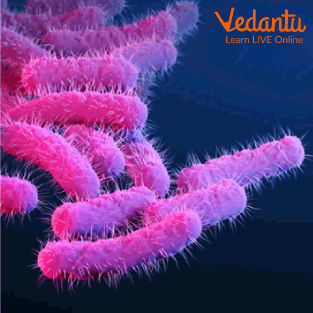
Kingdom Monera
There are different types of bacteria in this kingdom. Members of Monera are found wherever life is possible, such as in hot springs, under ice, on the deepest ocean floor, in the hottest and driest deserts, and in the bodies of other organisms. The wind can carry them away. They are in great numbers.
In 1683, Antony Van Leeuwenhoek of Holland, with the help of a microscope made by him, saw bacteria in tooth scraps and called them AnimalCules. For this reason, Leuwenhoek is called the Father of Bacteriology. In 1829, Ehrenberg named them bacteria (Scientific Name of Bacteria).
Bacteria Facts
Bacteria have been considered the first living organism on earth. They have been on the earth for the last 3 billion years.
The number of bacteria in your mouth is more than the total number of humans on earth.
The length of a bacteria ranges from 0.5 to 5 micrometres. They can be of any shape like round, circular or rod etc. (1 metre has 1 million micrometres).
Bacteria have the smallest eyes in nature but the largest in terms of body size.
There is not a single bacteria in the body of newborn babies.
The effect of chlorine in water lasts only for six months, after which bacteria start growing again in the water.
Parts of Bacteria
Bacteria can be a rod, spherical or coiled. Some bacteria grow as filaments (to which rod-like bacteria are attached, actinomycetes).
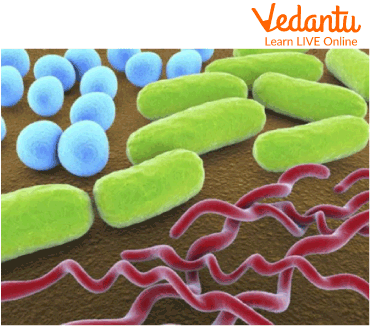
3 Common Shapes of Bacteria.
The bacterium lacks a true nucleus and receptor. Cocci-type bacteria have a diameter (of 0.5 – 2.5u). A drop of liquid can contain 50 million bacteria. In Bacillus types, the length of the bacteria is up to (3-15u).
Bacteria may or may not have small structures, such as flagella or hunter. They are used for swimming.
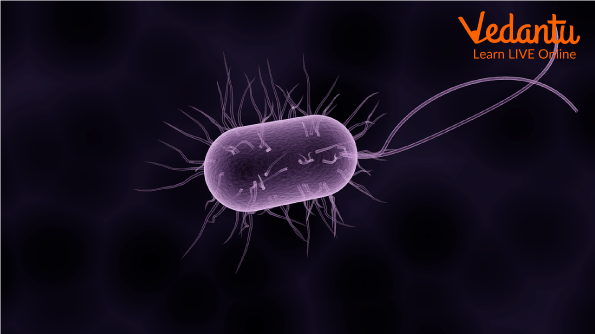
Flagella in Bacteria
Flagella can be on one or both ends of the bacterium, depending on the type of bacterium.
There are two types of bacteria based on structure and gram colouration: Gram-positive and Gram-negative.
On dyeing with violet colour, all the bacteria become blue and when these dyed bacteria are washed with alcohol by pouring a solution of Iodine-Potassium Iodide, then blue colour remains in some bacteria.
The bacteria which retain blue colour are called gram-positive bacteria and those which do not have blue colour are called gram-negative bacteria. After that, the gram-negative bacteria are coloured with another colour like safranin.
The substance of the cell wall of all eubacteria is murein or peptidoglycan.
It consists of polysaccharides that are cross-linked by chains of short amino acids.
Peptidoglycan has not been detected in any eukaryotes or archaebacteria.
In gram-negative bacteria, there is another surface above the peptidoglycan wall called the outer membrane.
It consists of lipopolysaccharide (a complex lipid-polysaccharide molecule) that is embedded in the membrane.
These cells have specific adhesive properties due to lipopolysaccharides.
This helps the bacterium stick to specific eukaryotic cells.
The internal structure of the bacterium can only be seen through the electron microscope by taking a thin cut of it.
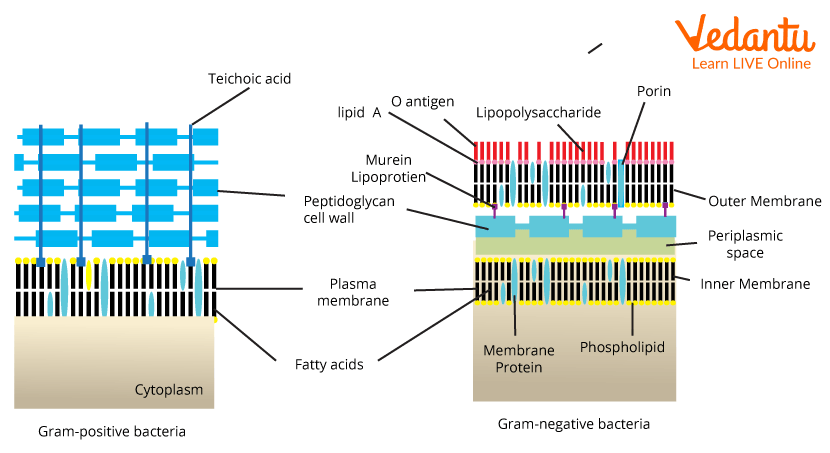
Peptidoglycan structure
The membrane-bound protoplasm is surrounded by a wall, due to the location of the ribosomes, the protoplasm appears double.
The ringed and coiled bacterial chromosomes (this is plain DNA) remain attached to the cell membrane at one point.
The base structure of the flagella is in the cell membrane where it can move, but it rotates when there is movement in the flagella that the bacterium moves.
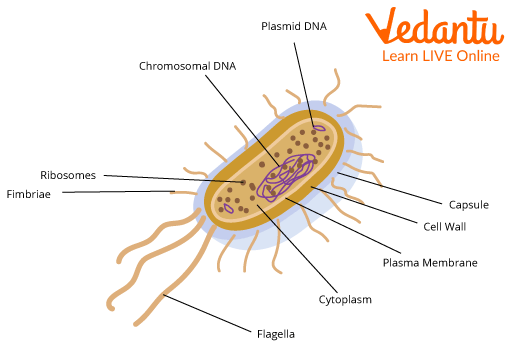
Internal Structure of Cell Membrane of Bacteria
Solved Questions
1. Who are the micro-organisms of Prokaryote Kingdom Monera?
Ans: Bacteria are the microorganisms of the prokaryotic kingdom Monera.
2. Which scientist is called the 'Father of Bacteriology'?
Ans: Antony van Leeuwenhoek is called the 'Father of Bacteriology'.
3. What is the material of all eubacteria cell walls?
Ans: Murine/Peptidoglycan is the material of all eubacteria cell walls.
Learning by Doing
What helps bacteria to stick to specific eukaryotic cells?
What is the approximate size of a bacterial cell?
In which cells the Peptidoglycan layer is present in large amounts?
Summary
Bacteria are unicellular organisms, although we cannot see them without a microscope. But there are one or two that can be seen with the naked eye. Bacteria are the oldest, smallest, simplest and most abundant micro-organisms of the prokaryotic kingdom Monera. There are different types of bacteria in this kingdom. Bacteria have been considered the first living organism on earth; they have been on the earth for the last 3 billion years. The number of bacteria in your mouth is more than the total number of humans on earth. Bacteria may or may not have small structures, such as flagella or hunter. The substance of the cell wall of all eubacteria is murein or peptidoglycan.
FAQs on Fascinating Facts About Bacteria Every Student Should Know
1. What are the basic parts of a bacterial cell?
A bacterium is a simple, single-celled organism. Its main parts include a protective cell wall, a cell membrane that controls what goes in and out, a jelly-like substance called cytoplasm, and its genetic material, which floats freely inside the cell as it lacks a true nucleus.
2. Are all bacteria harmful to humans?
No, not at all! In fact, most bacteria are harmless or even very helpful. We have 'good' bacteria in our gut that help us digest food. However, some types, called pathogenic bacteria, can cause illness. Examples of these 'bad' bacteria include Salmonella and Staphylococcus.
3. What are the different types of bacteria based on their shape?
Bacteria are often grouped by their shape. The four most common shapes are:
- Cocci: Spherical or round, like little balls.
- Bacilli: Rod-shaped, like tiny sticks.
- Spirilla: Spiral-shaped, like a corkscrew.
- Vibrio: Comma-shaped or curved rods.
4. What are some of the most important roles bacteria play in our world?
Bacteria are essential for life on Earth. They act as decomposers, breaking down dead plants and animals to recycle nutrients back into the soil. They are also vital for making foods like yogurt and cheese, and the helpful bacteria in our bodies support our immune system and digestion.
5. How are bacteria different from viruses?
The biggest difference is that bacteria are living, single-celled organisms that can reproduce on their own. Viruses are much smaller and are not considered fully 'alive' because they need to invade a living host cell to multiply. Also, antibiotics are effective against bacterial infections but do not work on viruses.
6. How can scientists see and study something as small as bacteria?
Since bacteria are invisible to the naked eye, scientists use powerful microscopes to magnify them. To study them further, they often grow bacteria in a lab on a nutrient-rich substance called agar. This allows the bacteria to multiply into millions, forming a visible cluster known as a colony that is easy to study.
7. What does it mean for bacteria to become 'resistant' to antibiotics?
Antibiotic resistance happens when bacteria change or evolve in a way that stops a specific medicine from working against them. This means the antibiotic can no longer kill the bacteria or stop them from growing, making infections much harder to treat. It is a major global health concern.
8. Could life on Earth exist without bacteria?
It is highly unlikely. Bacteria play fundamental roles that no other organisms can fill. They produce oxygen, recycle essential nutrients like carbon and nitrogen through decomposition, and form the foundation of many food webs. Without them, ecosystems would collapse.





















